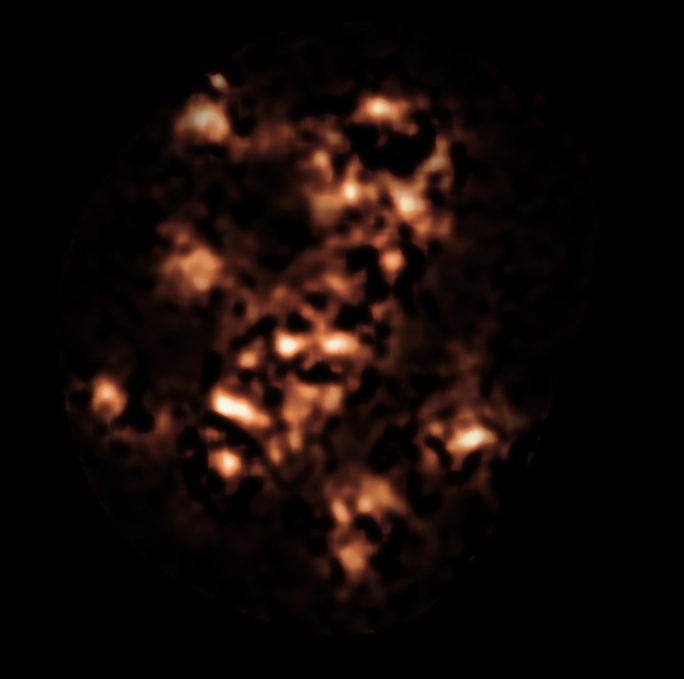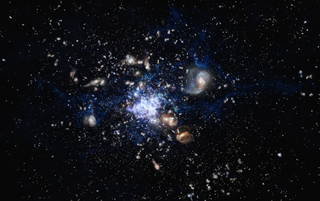Galactic 'Mega City' Shows Mysterious Spots of Star Formation (Images)

A new photo of a huge galactic "mega city" under construction in the early universe shows star formation happening in unexpected places, scientists have found.
The new image of the Spiderweb Galaxy (also known as MRC 1138-262) shows blobs of dust that are actually galaxies, captured by a European Southern Observatory telescope in Chile. The entire galaxy cluster surrounds a radio galaxy that has a supermassive black hole at its center. ESO also released a video flythrough of the galaxy image, and you can see it on Space.com
Here's where the surprise came: Scientists discovered that 10 billion years ago, star formation was happening mostly in one spot that wasn't at the center of the galaxy complex. Astronomers instead thought star formation would happen in the filaments of the cluster. Why is unclear.
"We aimed to find the hidden star formation in the Spiderweb cluster — and succeeded — but we unearthed a new mystery in the process; it was not where we expected," lead researcher Helmut Dannerbauer, a post-doctoral galaxy researcher at the University of Vienna, Austria, said in a statement. "The mega city is developing asymmetrically."

Galaxy clusters are the largest structures in the universe, but their formation and evolution is poorly understood.
The image was captured using the ESO's Atacama Pathfinder Experiment telescope (APEX) telescope in Chile.
APEX examined the galaxy cluster in submillimeter wavelengths designed to penetrate dust. Across 40 hours of observations, the researchers found four times as many sources of star formation than previously known.
Get the Space.com Newsletter
Breaking space news, the latest updates on rocket launches, skywatching events and more!

"This is one of the deepest observations ever made with APEX and pushes the technology to its limits – as well as the endurance of the staff working at the high-altitude APEX site," Carlos De Breuck, a co-author on the study who is the APEX project scientist at ESO said in the same statement.
These starbirth hubs are happening at the same distance as the cluster itself, according to observations using other wavelengths of light, which shows the star-formation regions must be part of the cluster.
Follow Elizabeth Howell @howellspace. Follow us @Spacedotcom, Facebook and Google+. Original article on Space.com.
Join our Space Forums to keep talking space on the latest missions, night sky and more! And if you have a news tip, correction or comment, let us know at: community@space.com.

Elizabeth Howell (she/her), Ph.D., is a staff writer in the spaceflight channel since 2022 covering diversity, education and gaming as well. She was contributing writer for Space.com for 10 years before joining full-time. Elizabeth's reporting includes multiple exclusives with the White House and Office of the Vice-President of the United States, an exclusive conversation with aspiring space tourist (and NSYNC bassist) Lance Bass, speaking several times with the International Space Station, witnessing five human spaceflight launches on two continents, flying parabolic, working inside a spacesuit, and participating in a simulated Mars mission. Her latest book, "Why Am I Taller?", is co-written with astronaut Dave Williams. Elizabeth holds a Ph.D. and M.Sc. in Space Studies from the University of North Dakota, a Bachelor of Journalism from Canada's Carleton University and a Bachelor of History from Canada's Athabasca University. Elizabeth is also a post-secondary instructor in communications and science at several institutions since 2015; her experience includes developing and teaching an astronomy course at Canada's Algonquin College (with Indigenous content as well) to more than 1,000 students since 2020. Elizabeth first got interested in space after watching the movie Apollo 13 in 1996, and still wants to be an astronaut someday. Mastodon: https://qoto.org/@howellspace